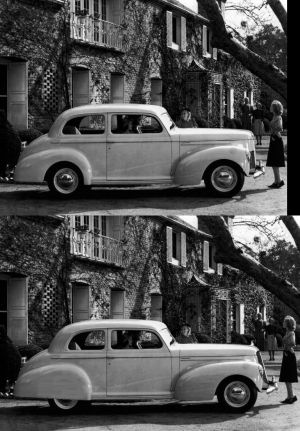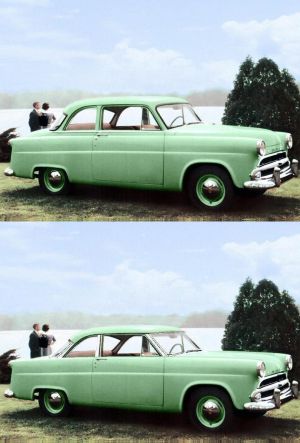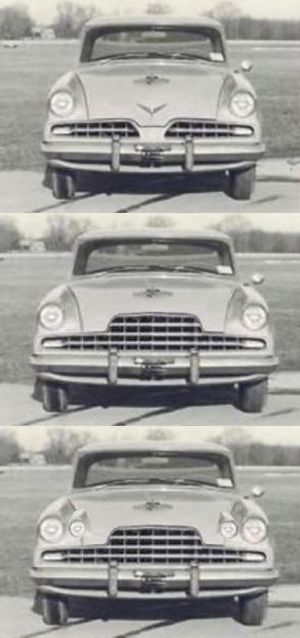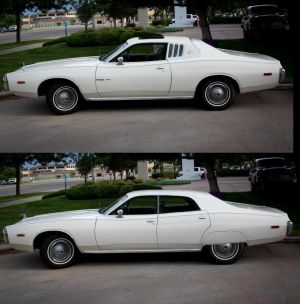- Home
- About Us
- Join/Renew
- Member Benefits
- Member Pages
- Log In
- Help
- Museum Store
Tony,
On your suggestion to offer small car of high quality, styling and performance, had Pierce shared with Studebaker perhaps the first good opportunity would have been to offer its version of ’39 Champion, priced around $1,600. I lengthened the axle-to-dash by 9 inches and laid the grill back in classic Pierce style, also widened the C-pillar. What would have powered the car? Big Six from Studebaker? Six version of Pierce’s Eight? Eight version of Champion’s new small, low cost Six? All new OHV six, small Eight or V8?
Affluent folks who didn’t want to drive a big car might have shown interest. Champion came in several body styles so lots of choice.

Jet might have also offered opportunity, the car aesthetically sound from the beltline down. Reworking the top portion might have made it a nice Hudson 2+2 as shown, or with unique grill and maybe a longer hood the return of the Pierce motorette. One wonders whether Pierce, had it based its first post-war car on Hudson but remained independent, might have attempted to actually buy Hudson in 1953 when Barit was forced to sell.

The existence of Pierce in the Fifties might have changed lots of history depending on who it teamed with. If Hudson, would Nash have still bought Hudson, getting all its dealers and allowing Romney to eventually sell lots of Ramblers? Would Packard have felt the pressure to join Nash sooner rather than later, to replicate Pierce/Hudson’s success?
If Studebaker was its partner, would Packard have ever attempted to purchase that company, or would it have instead gone it alone or agreed to George Mason’s offer to join AMC? Would Pierce have attempted to buy Studebaker after Studebaker most likely would have filed for bankruptcy by 1956? Or would Pierce have instead switched to Chrysler or AMC (Rambler doors?) for its 1957 line-up, seeing Studebaker as a liability as early as 1954?
Here’s a look at would-be Pierce-Arrow based on Studebaker’s all new 1953 body, designed by Loewy’s studio. Same strategy as in ’47… 8 inches added to width, axle-to-dash and rear overhang, and C-pillar widened (2 inches in this case) to give that surface more visual weight and allow for extra rear legroom. Vehicle height of 60.5 inches would have made the series just about as low as Hudson and several inches lower than Cadillac, Lincoln and Imperial.
I think Loewy did a great job overall but agree with Nance, the front was a bit droopy (he referred to it as something else). Also, the proud headlights were becoming dated, the industry moving towards a more integrated lighting/grill/bumper appearance.

Unlike Studebaker’s body engineers, who appear to have been perfectly content to butcher Loewy’s body and B and C-pillar surfaces with ugly door cut lines, Pierce’s engineers would hopefully have been attuned to the demands of the luxury segment and thus willing to help Pierce’s designers achieve their vision to greatest extent possible. Carryover Studebaker Land Cruiser rear door with some modification at top rear, and hinge location reversed to enable elimination of body insert below B-pillar. Longer front door would have closed the gap and allowed a few inches more elbow-on-the-sill room for driver. Door outer stamping would have come from coupe’s front door, trimmed.
Haven’t tried to modify the famous Loewy coupe, which sat only 56.5 inches high, but widened and lengthened can imagine the result being a very sporty Pierce hardtop personal coupe and convertible.

Wanted to show you one more image that takes the story all the way to the Seventies, assuming that Pierce had found its way to Chrysler by this time.
The cars of this decade have long been derided by some as inferior to those that came before but I think that certain styling and engineering achievements represented a post-war high point for the American car industry. True, emissions and bumper regulations impacted performance and appearance but the former also drove advancements such as more widespread use of fuel injection, which improved both performance and fuel economy.
The large luxury car market at this time faced headwinds from both high gas prices and smaller, more sophisticated cars such as those offered by Mercedes-Benz, particularly the all-new 1973 S-Class. Cadillac responded with the 1976 Seville, a good but compromised effort that rather than making major inroads into Mercedes’ customer base, was mostly bought by existing Cadillac customers who wanted an easier car to drive and park.
Pierce would have needed to diversify too, continuing to sell its traditional large cars but also fielding something smaller and sportier. The year 1971 would have presented a good opportunity with the redesigned Dodge Coronet and Charger. I had to really search to find this ’73 white Charger that was not equipped with typical muscle car wheels and trim because for Pierce, sporting elegance might have been a worthwhile goal. I kept the hood but increased the axle-to-dash by 3 inches, body by 6 inches for rear legroom, and wheel size from 14 to 15 inches. I also converted the coupe style to a 4 door sedan to help differentiate it from the Charger. Try to envision with hidden headlights and grill similar in appearance to the ’70 Imperial, which would have been classier and more upscale than the Charger’s version. Taillights would have differed from Charger too, distinctive but understated. Underhood, a Chrysler-sourced V8 with fuel injection, and rear suspension redesigned by Pierce to be fully independent. Inside, top notch materials and seating for 6 and optionally 4 or 5.
Think 1920s Pierce strategy, when one could order a sporty 4 passenger touring car with lowered seats and windshield.
Believe it or not, have also worked out a wonderful Pierce sport sedan based on the ’76-80 Aspen! The coupe version of course, which had very good body surfacing. The ’81 Imperial coupe likely would have served as the last Chrysler RWD donor car though am not a fan of that era’s boxy styling. At some point Pierce probably would have needed to develop its own cars from the ground up, the high end global luxury market by the 1980s being strong enough to support.

Your attempts with the Champion, Jet, Airflow and Lowey’s ’50’s
Studebaker, brought back memories of the ’58 Packard-Baker. Today the
entry level Mercedes are careful to not share a platform with a
lesser make, though Audi gets away with it through its VW connection.
The Templar was engineered as a fine car. How can you start with a
$710 Champion (you could buy the cheapest Ford for $706) and end up
with a car that would show up on a Pierce-Arrow sales floor (and have
a smile on the dealer’s face)? It smacks of the Brewster/Ford V8
combo with the grill shaped like a heart or Franklin’s marriage to
a REO body and chassis resulting in the first muscle car (?), the
Olympic. Dropping that 100 horsepower air-cooled engine in and
ditching the radiator and water-cooled weight, really made that $1,385
car scoot. It didn’t save Franklin or REO though.
